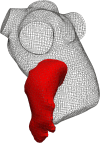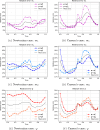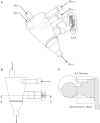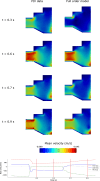A reduced order model formulation for left atrium flow: an atrial fibrillation case
- PMID: 38753292
- PMCID: PMC11341613
- DOI: 10.1007/s10237-024-01847-1
A reduced order model formulation for left atrium flow: an atrial fibrillation case
Abstract
A data-driven reduced order model (ROM) based on a proper orthogonal decomposition-radial basis function (POD-RBF) approach is adopted in this paper for the analysis of blood flow dynamics in a patient-specific case of atrial fibrillation (AF). The full order model (FOM) is represented by incompressible Navier-Stokes equations, discretized with a finite volume (FV) approach. Both the Newtonian and the Casson's constitutive laws are employed. The aim is to build a computational tool able to efficiently and accurately reconstruct the patterns of relevant hemodynamics indices related to the stasis of the blood in a physical parametrization framework including the cardiac output in the Newtonian case and also the plasma viscosity and the hematocrit in the non-Newtonian one. Many FOM-ROM comparisons are shown to analyze the performance of our approach as regards errors and computational speed-up.
Keywords: Cardiovascular flows; Data-driven models; Hemodynamics; Left atrium; Patient-specific configurations; Reduced order model.
© 2024. The Author(s).
Figures















References
-
- Atwell JA, King BB (2001) Proper orthogonal decomposition for reduced basis feedback controllers for parabolic equations. Math Comput Model 33(1–3):1–1910.1016/S0895-7177(00)00225-9 - DOI
-
- Ballarin F, Faggiano E, Ippolito S, Manzoni A, Quarteroni A, Rozza G, Scrofani R (2016) Fast simulations of patient-specific haemodynamics of coronary artery bypass grafts based on a POD-Galerkin method and a vascular shape parametrization. J Comput Phys 315:609–62810.1016/j.jcp.2016.03.065 - DOI
-
- Balzotti C, Siena P, Girfoglio M, Quaini A, Rozza G (2022) A data-driven reduced order method for parametric optimal blood flow control: application to coronary bypass graft. Commun Optim Theory 2022(26):1–19
MeSH terms
Grants and funding
LinkOut - more resources
Full Text Sources
Medical

